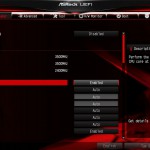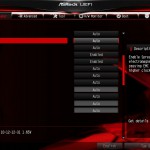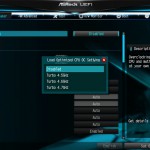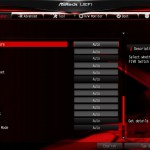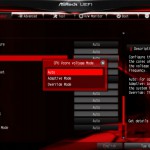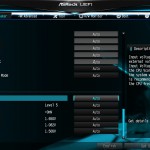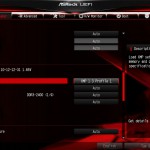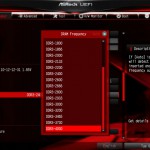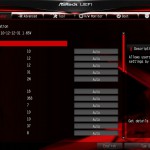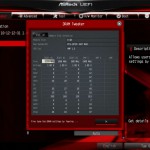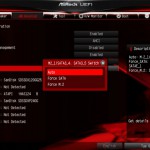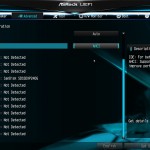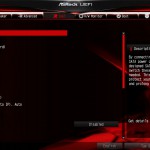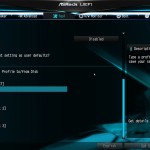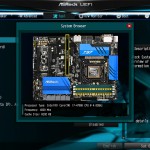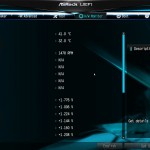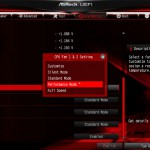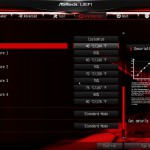Firstly, we are pleased to report that our NZXT Avatar S mouse worked to its usual standard in the ASRock Z97 Extreme6 motherboard’s UEFI BIOS.
ASRock is using a high resolution, 1920×1080, approach for its Z97 UEFI BIOS. The implementation used on ASRock's Z97 Extreme6 motherboard is representative of the company's Z97 UEFI design, hence our analysis is similar to that of the ASRock Z97X Killer motherboard.
ASRock has added a favourites section to the main page, allowing users to quickly jump to commonly-accessed settings.
A UEFI Guide tool is also provided, allowing users to be guided through the interface to gain knowledge about it.
ASRock provides users with a good amount of frequency tweaking options. Automatic CPU overclocking profiles allow frequencies of up to 4.7GHz (with a 4790K installed) to be selected, although the feasibility of such settings will be tied to a CPU's potential.
An extensive range of voltage and power settings can be adjusted in ASRock's Z97 UEFI BIOS.
Offset voltages can be set, or users can opt for manually-configured static levels.
ASRock allows users to select memory dividers for DRAM frequencies of up to 4GHz. That kind of multiplier is going to be impossible to reach for Haswell-based chips.
Timings can be adjusted via their own section and a tweaking tool.
Operation of the M.2 connector can be manually set via the UEFI, if such an approach is preferred.
Drives connected to the SATA and M.2 interface can be accessed to toggle their hot-swap operation.
ASRock includes a number of convenient tools in its UEFI. Users can rapidly apply a number of system configurations and drivers can also be downloaded via the interface.
Three overclocking profiles can be saved to ASRock's Z97 UEFI. I would complain about three profiles being provided on an overclocking-orientated board, but the Z97 Extreme6's target audience is likely to find a trio of save points sufficient.
And if three is not enough, ASRock allows the named profiles to be copied to and from a USB flash drive.
A positive for ASRock is the interface's ability to scan through a USB drive to search for a BIOS file. Users simply select the Simple Flash tool and the board scans until a BIOS file is found and can be used to update the revision.
System Browser is a convenient tool that displays which components are connected to the motherboard. The tool is particularly useful for troubleshooting purposes; if, for example, a memory stick is faulty, it will not show up in the System Browser window.
ASRock includes a balanced set of voltage, temperature, and fan speed readings on its HWMonitor page. Operation of the CPU and chassis fans can be set to pre-defined configurations via the BIOS, or a user can create their own profile.
The method for creating a fan speed profile is far less intuitive than the approach adopted by some competitors; ASRock forces users to select from a list of numbers whereas some other vendors allow points to be toggled on a graph which shows the fan speed curve.
Overall, ASRock UEFI's implementation is a positive one. While it's not quite at the same level as Asus' implementation, it does have its merits in comparison to the interfaces used by MSI and Gigabyte. The System Browser tool is useful and a high resolution is most certainly welcomed. The interface is also relatively easy to navigate and does not swamp users with information.
There are a few layout adjustments that we would welcomed. Placing the saving points for settings profiles on the OC Tweaker page would make sense. We weren't admirers of the basic fan profile creation method, either.
But as far as UEFI implementations go, ASRock's updated Z97 offering is clearly one of the better options. I would go as far as saying it is my second favourite interface to use, bested only by Asus' near-perfect implementation.
 KitGuru KitGuru.net – Tech News | Hardware News | Hardware Reviews | IOS | Mobile | Gaming | Graphics Cards
KitGuru KitGuru.net – Tech News | Hardware News | Hardware Reviews | IOS | Mobile | Gaming | Graphics Cards



